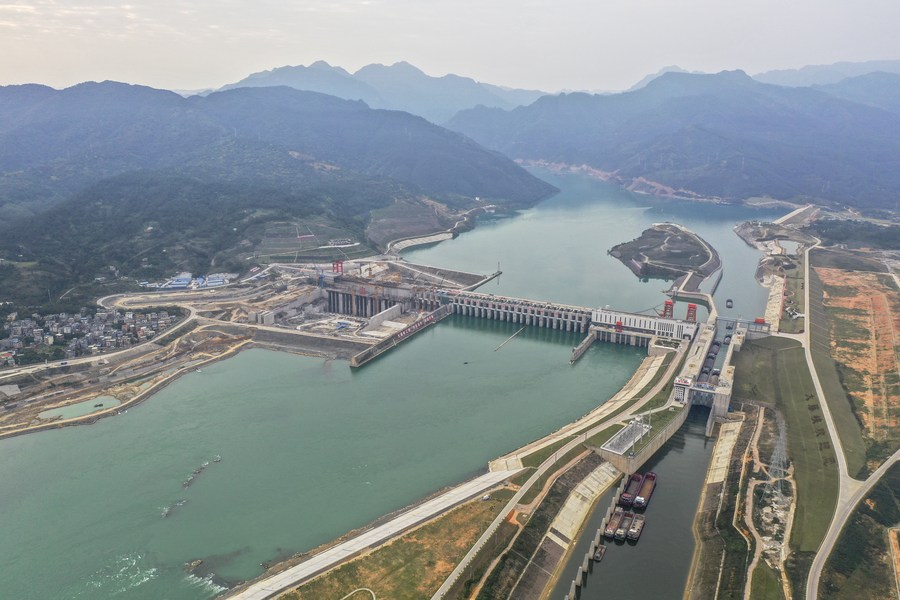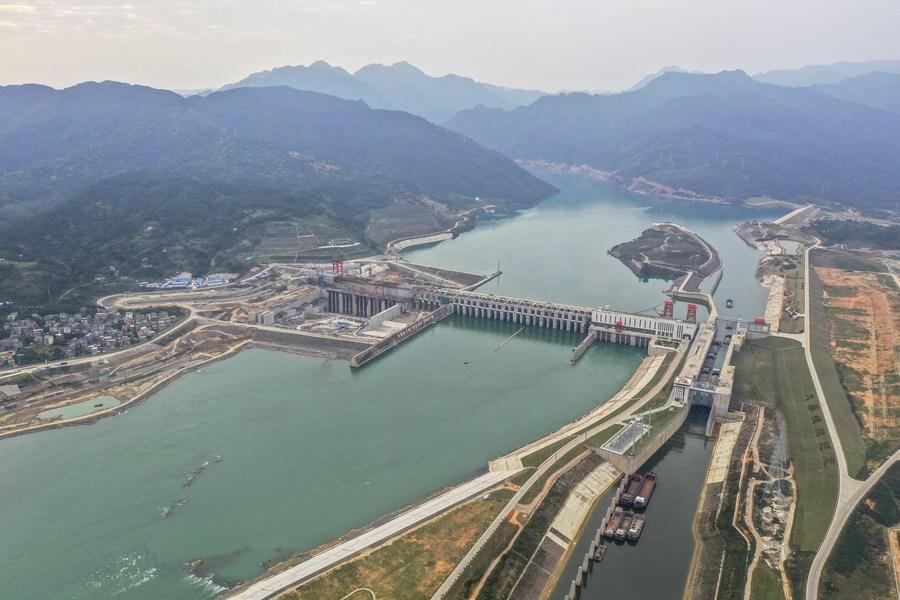
Aerial photo taken on March 11, 2022 shows the Dateng Gorge water conservancy project in Guiping, south China's Guangxi Zhuang Autonomous Region. (Xinhua/Cao Yiming)
BEIJING, May 21 (Xinhua) -- China is accelerating the construction of water conservancy projects amid the country's efforts to expand domestic demand, stabilize its economy and promote high-quality development.
In the first four months, China's investment in water conservancy facilities jumped 45.5 percent year on year to 195.8 billion yuan (about 29 billion U.S. dollars), according to the Ministry of Water Resources. The country plans to launch more than 30 water conservancy construction projects in 2022 involving about 800 billion yuan.
A key river improvement program, one of the new projects set for this year, was launched in the Yangtze River Delta region on May 16. The program, the Wusong river improvement project, will cost about 83.1 billion yuan and consist of two sections in Jiangsu Province and Shanghai.
The program will improve flood control in areas around Taihu Lake, China's third-largest freshwater lake, noted Minister of Water Resources Li Guoying. It will also restore regional water ecology and increase the river shipping capacity between Suzhou and Shanghai.
The construction of key water conservancy projects is conducive to China's efforts in expanding domestic demand, stabilizing its economy, promoting high-quality development and fostering a new development pattern, Li said.
China plans to accelerate research on key water conservancy technology this year, involving 42 projects, according to the ministry.
After years of efforts, China's scientific and technological innovation in water conservation has made remarkable progress. But there are still many shortcomings in original innovation, basic research, cutting-edge technology research, and the efficiency of the innovation system, Li said.
The research projects will involve flood and drought disaster prevention, intensive and economical use of water resources, and river and lake protection.
Major water conservancy projects usually face difficulties in advancing preliminary work as the process involves multiple departments. The projects also encounter fundraising pressure, which means they rely mainly on government investment.
To address these difficulties, the ministry and relevant departments have established communication mechanisms to discuss issues on the preliminary work of projects. They have also endeavored to increase financing channels such as special-purpose bonds for local governments, financial capital and social capital while striving to enhance central government fiscal support.
Policy banks have been channeling funds to key water conservancy projects.
The Agricultural Development Bank of China, China's rural policy bank, had issued over 1 trillion yuan of loans to water conservancy by the end of March. The figure came from an average annual growth rate of 16 percent since 15 years ago, the bank said, adding that the outstanding loans stood at 528.3 billion yuan at the end of March.
China Development Bank has strengthened support for water conservancy in the first quarter, pledging loans worth 35.5 billion yuan, with 22.9 billion yuan already released. The funds will go to major water conservation projects, flood prevention, disaster relief, rural water supply, and environmental projects, the bank said.
By the end of March, the issuance of special-purpose bonds for local governments totaled around 1.25 trillion yuan. Much of the funds were channeled into infrastructure construction such as the development of industrial parks, transport, water conservancy facilities and cold-chain logistics.
The water conservancy departments at all levels should fast-track the approval process for water conservancy projects and ensure they can be launched as soon as possible, to help the country stabilize the economy and achieve its economic targets set for this year, Li said.




 A single purchase
A single purchase









